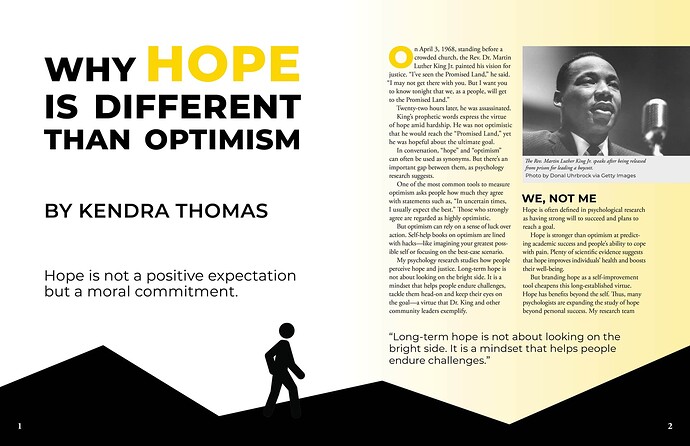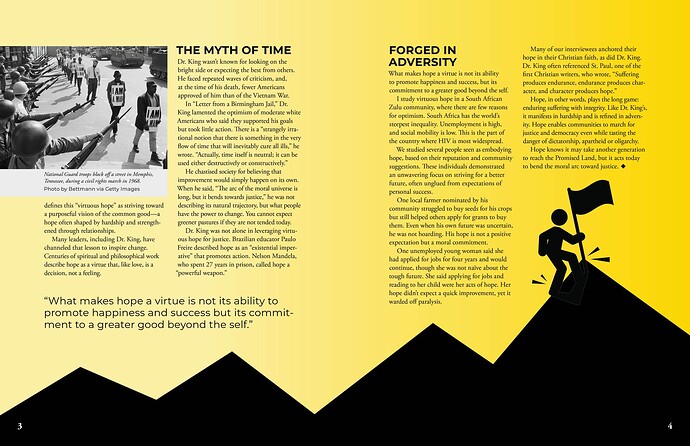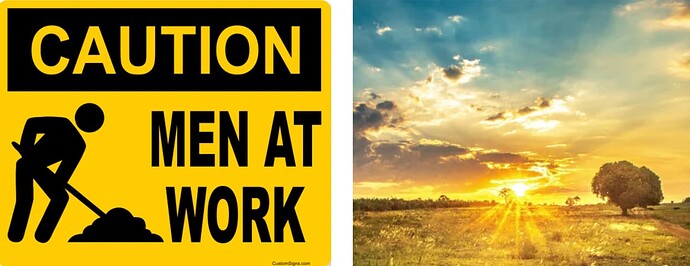For my university design class, I was tasked to create a 4-page print magazine article. The audience is activists or people interested in making the world a better place. I would be grateful for any suggestions for improvement.
Welcome to the forum. ![]()
The forum rules prohibit making the same post in multiple parts of the forum. Your request for a critique of your magazine article can go in the Crit Pit or the Student section, but not both, so I removed the Crit Pit copy. It’s not a big deal — just trying to keep things organized. ![]()
As for comments, what’s your reasoning behind your choice of colors: yellow and black?
Good to know, thanks! I chose black to try to be consistent with the black-and-white photos and yellow to try to represent hope (like moving toward light or the sunrise). I’m open to other color schemes though.
Yellow might represent hope, but will the readers pick up on that association? Black and yellow are also the colors of police tape and warning signs. To me, your color choices and illustrative graphics lean more toward no-nonsense, hard-edged, and abrupt black-and-yellow caution signs than the hopeful quality you wanted to convey.
As you know, colors have strong emotional and psychological associations, but it’s not straightforward. Yellow doesn’t necessarily convey hope, blue doesn’t always suggest tranquility, and red doesn’t always communicate an emergency. Using color to evoke emotional responses is an important tool in designers’ toolboxes, but there’s no easy recipe that reduces down to this or that color evoking this or that emotion.
Instead, the recipe for emotions is the sum of all the ingredients, which includes, along with color combinations, the impact of photos, headlines, graphics, typography, and all the elements of design.
I’ve found the best way to deal with this conundrum is to imagine myself as the viewer and then allow myself to feel the emotions that my design choices evoke. It takes practice, and it’s an iterative process of trying one thing and evaluating whether it feels too hard or too soft, too happy or too sad, too this or too that, and then changing whatever is needed to evoke the emotional association I intended.
Black and yellow… Bees sting
Black and yellow not good
I’ve done work for a lot of designers doing a lot of educational exhibits over the last decade involving Civil Rights and Slavery.
90% of them have used black, yellow and a form of orange red. Actually, I think all of them have. They differ in the choice of secondaries, but that seems to be a theme.
I wonder if the OP has viewed some of these and absorbed the influence?
Normally, odd numbers are for right-hand pages.
After glancing at the layout for the first time, the first thing I thought of was “danger,” “caution,” “police.” The color scheme does not represent hope to me. It looks like the layout belongs in a construction magazine.
I’ll say this … we get student magazine spreads to critique from time to time. While you work is not pro-level, which I wouldn’t expect it to be given that you’re a student, you’re showing more understanding than some of the others. It appears that you’ve thought about it, came up with a graphic motif (climbing the mountain) that ties in with the article, and you’ve tried to tie the two spreads together.
In general, try to minimize hyphenation. This is certainly true for body copy and especially true for display copy (the pull quote on page 2). I’d never hyphenate display copy unless there is some case where it is used as some sort of a graphic element.
Look up hanging punctuation. The introductory quote marks on both of the pull quotes need to be hanging.
Turn on your baseline grid and make sure the baselines are lined up across the pages — at least for the body copy.


